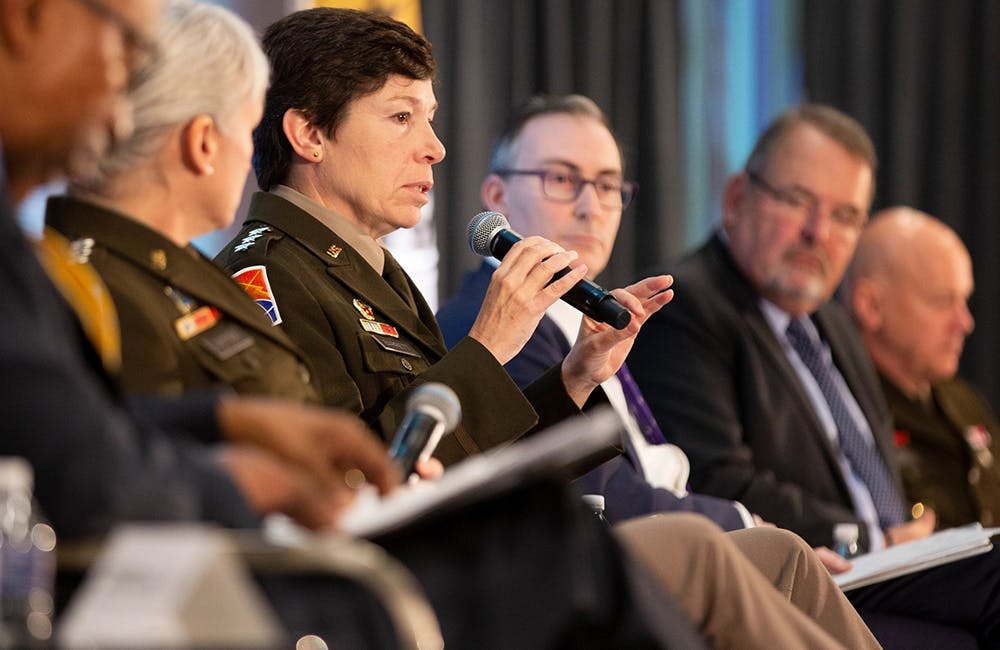Army Says ‘Speed is of the Essence’ When it Comes to Cyber
Army is taking a cross-government, multi-nation approach to securing cyber at speed.

U.S. Army cyber leaders explain how a crosscutting cyber approach will help the service maintain an information advantage across the evolving threat landscape.
“Information advantage is not… relegated to a couple people on staff with some special skills. It is all inclusive,” Lt. Gen. Maria Barrett, commanding general of the Army Cyber Command, during AUSA’s Annual Meeting in Washington D.C. Wednesday.
China is the Army’s “primary facing challenge,” having policy, strategy, doctrine and millions of dollars invested in science and technology, Lt. Gen. Laura Potter, Army deputy chief of staff, G-2, explained. Russia is also a top adversary, posing a threat through its mis- and disinformation strategy.
“[China has] the ability to contest us across that full spectrum that this panel addresses from very sophisticated high and cyber threats,” Potter added. “This is really a global problem that all the adversaries we talked about in National Defense Strategy are putting a significant amount of effort into.”
Lt. Gen. John Morrison, Army deputy chief of staff, G-6, explained that information advantage, at its core, is about decision dominance. The speed of exploitation is requiring the Army to investigate new ways to get ahead of evolving threats quickly. While the Army could use traditional intelligence sources to identify threats, Barrett is looking into how the service can “see further,” faster.
The Army is implementing a framework to enable the service to conduct iterative capability development. The framework will rapidly harmonize data and provide it to the right commander to enable data-driven decisions.
“You have to reach out further, and so you have to have the tools at your disposal to do that. That ends up being a lot of data, and you have to have the mechanisms in order to go after that,” Barrett said. “As we start thinking about sensor to shooter data, and leveraging all of this… How is the commander going to sense, understand, decide, act and assess faster than that of the adversary and create those windows to exploit?”
The Army is focusing on bolstering its cyber defense, while improving user experience. The service has made significant force structure investments across the total Army analysis process that are now moving into the service’s regional cyber centers, Morrison said. Aligning people and organizational design appropriately to operate, maintain, secure and maneuver the network will be the foundation of Army’s cyber strategy.
Underpinning the Army’s technical advances is cyber talent.
“A shout out to the United States Congress and Senate for the authority to have a cyber excepted service as an example of a way to fast track hiring and really improve the retention of talent that you’re going to need if you’re going to have information advantage. So, taking advantage of the authorities that we have for talent is absolutely critical for information advantage,” said Dr. Michael Sulmeyer, principal cyber advisor to the Secretary of the Army.
Looking ahead, the Army plans to build out its AI and machine learning capabilities. Morrison noted that he’d like to implement a model that builds off of Project Convergence to iterate faster.
“Swinging for the fences is not where we’re trying to go with artificial intelligence and machine learning. We want to be iterative; we want to evolve,” Morrison added.
“The FY 23 NDAA. That bill includes a provision that would require Cyber Command to create a five-year roadmap for rapidly adopting… tools to support the cyber mission,” Sen. Mike Rounds said. “We need Cyber Command, with the support from all the military service—specifically from DARPA—to make sure our soldiers and warfighters have the most innovative technologies that we can possibly get… AI is absolutely at the top of the list.”
This is a carousel with manually rotating slides. Use Next and Previous buttons to navigate or jump to a slide with the slide dots
-

DOD Has a New Cyber Resiliency Assessment Program
Defense officials tout the continuous assessment feature and scalability of the new program amid increased cyber threats.
5m read -

Cyber Resilience and Recovery Amid Evolving Cyber Threats
Data durability is a key aspect of NIST’s cybersecurity framework for public and private organizations.
21m listen -

The CAIOs Leading Responsible AI Development Across Government
Since the White House's AI executive order, federal agencies are in the process of naming chief artificial intelligence officers.
7m read -

How TMF is Helping Agencies Accelerate Tech Modernization
The program launched a new AI pilot to expedite TMF applications as agency leaders urge more to consider applying for funds.
4m read








